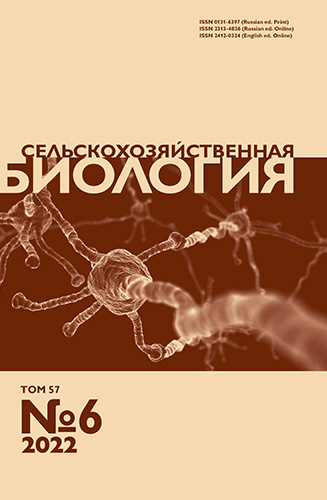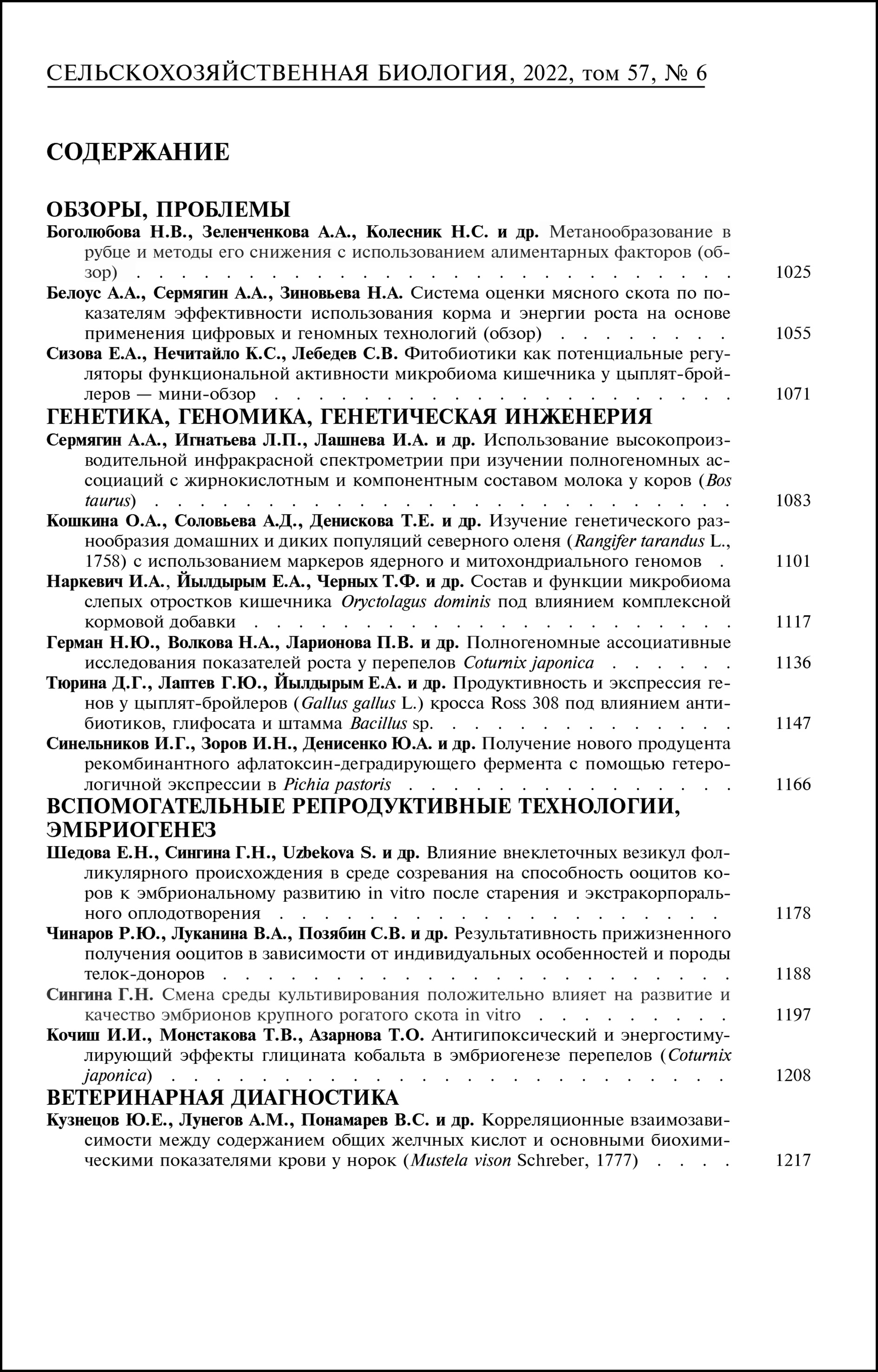doi: 10.15389/agrobiology.2022.6.1217rus
УДК 619:636.934.57:591.11:577.117.2
Исследование выполнено за счет гранта Российского научного фонда № 22-26-00158, https://rscf.ru/project/22-26-00158/.
КОРРЕЛЯЦИОННЫЕ ВЗАИМОЗАВИСИМОСТИ
МЕЖДУ СОДЕРЖАНИЕМ ОБЩИХ ЖЕЛЧНЫХ КИСЛОТ
И ОСНОВНЫМИ БИОХИМИЧЕСКИМИ ПОКАЗАТЕЛЯМИ КРОВИ
У НОРОК (Mustela vison Schreber, 1777)
Ю.Е. КУЗНЕЦОВ✉, А.М. ЛУНЕГОВ, В.С. ПОНАМАРЕВ,
Е.Б. РОМАШОВА
Заболевания печени различного генеза и степени тяжести, возникающие в результате постепенного разрушения желчных протоков, вызывают накопление желчных кислот в печени, желчи и сыворотке крови, которое индуцирует провоспалительный ответ и повышенную продукцию активных форм кислорода, что приводит к цитотоксичным эффектам. Любое снижение эффективности экстракции, вызванное нарушениями функций печени, ведет к повышению количества общих желчных кислот в сыворотке крови. Их содержание в сыворотке или плазме крови — чувствительный показатель состояния печени, отражающий как печеночный синтез и секрецию, так и реабсорбцию. Тестирование сыворотки крови может выявить нарушения функции печени до формирования более выраженных клинических признаков. Целью нашей работы было обнаружение корреляционных связей между стандартными биохимическими показателями и содержанием желчных кислот в сыворотке крови, которое также оценили как предиктора состояния гепатобилиарной системы. Опыты проводили на звероферме «Мермерины» (д. Мермерины, Калининский р-н, Тверская обл., 2022 год). В качестве модельных животных были выбраны норки (Mustela vison Schreber, 1777) породы паломино. У 100 самок и 100 самцов в возрасте 1 год брали кровь из надреза кончика хвоста. Основной критерий отбора норок — отсутствие клинических проявлений патологий печени. Содержание общего белка, альбуминов, общего билирубина, щелочной фосфатазы, глюкозы, холестерина, общих желчных кислот, коэффициент де Ритиса определяли на биохимическом анализаторе URIT 8021A VET («URIT Medical Electronic Group Co., Ltd.», Китай). Общие желчные кислоты детектировали с использованием BSBE-набора для определения желчных кислот («BSBE», Китай). Был проведен расчет корреляционных взаимосвязей (коэффициент ранговой корреляции Спирмена и корреляционно-регрессионный анализ) между классическими предикторами состояния гепатобилиарной системы (количество общего белка, альбуминов, общего билирубина, щелочной фосфатазы, глюкозы, холестерина, коэффициент де Ритиса) и общими желчными кислотами. Установлено, что оценка общего количества желчных кислот может стать перспективным способом выявления патологий гепатобилиарной системы, особенно тех, которые сопровождаются нарушением белкового и жирового обменов, что подтверждается стойкими корреляционными взаимосвязями содержания желчных кислот с активностью щелочной фосфатазы и коэффициентом де Ритиса. Связь между этими показателями согласуется с биохимическими свойствами анализируемых соединений. Желчные кислоты способны стимулировать синтез щелочной фосфатазы, а цитотоксическая или цитопротекторная функция различных представителей пула желчных кислот напрямую влияет на количество аланинаминотрансферазы и на коэффициент де Ритиса. Совпадение значений, полученных с использованием двух методик статистического анализа корреляций при высокий доверительной вероятности (Р > 95 %), свидетельствовало о достоверном характере выявленных взаимосвязей. При этом наблюдалась неоднородность полученных результатов в зависимости от пола животных. У самцов прослеживалась наиболее очевидная связь количества желчных кислот с холестерином и альбуминами (прямая умеренная — 0,2 ≥r≤ 0,5 по методике расчета корреляционно-регрессионного анализа и 0,3 ≥r≤ 0,5 по методике расчета коэффициента корреляции Спирмена), у самок — с общим белком и билирубином (прямая высокая — 0,7 ≥r≤ 0,9 по методике расчета корреляционно-регрессионного анализа и 0,7 ≥ r≤ 0,9 по методике расчета коэффициента корреляции Спирмена).
Ключевые слова: желчные кислоты, норки, гепатобилиарная система, печень, биохимические показатели, корреляция.
Yu.E. Kuznetsov✉, A.M. Lunegov, V.S. Ponamarev, E.B. Romashova
Liver diseases of various origins and complications arising from the gradual destruction of the bile ducts cause the accumulation of bile acids in the liver, bile, and blood serum. This induces a pro-inflammatory response and an increased production of reactive oxygen species, leading to cytotoxic effects. Any decrease in extraction efficiency caused by impaired liver function leads to an increase in the level of total bile acids in the blood serum. Serum or plasma bile acid levels are sensitive measures of liver function in all species, reflecting both hepatic synthesis, secretion, and reabsorptive function. Thus, testing of blood serum can reveal functional abnormalities of liver function before the formation of more pronounced clinical signs. This high sensitivity is very important for making a clinical diagnosis. The novelty of the research lies in the study of the correlation between the bile acids and other biochemical parameters associated with the functional state of the liver, which was carried out for the first time. The aim of the work was to identify the correlation between standard biochemical parameters and the content of bile acids in the blood serum, as well as to evaluate the bile acids in the blood serum as a predictor of the state of the hepatobiliary system. The experiments were carried out in 2022 at the Mermeriny fur farm (village Mermeriny, Kalinin District, Tver Province). Palomino minks (Mustela vison Schreber, 1777) were chosen as model animals. Blood sampling from 100 females and 100 males at the age of 1 year was performed by cutting the tip of the tail. The main criterion for the selection of minks is the absence of clinical signs of liver pathologies. The content of total protein, albumin, total bilirubin, alkaline phosphatase, glucose, cholesterol, total bile acids, de Ritis coefficient was determined on a biochemical analyzer URIT 8021A VET (RIT Medical Electronic Group Co., Ltd., China). Total bile acids were detected using the BSBE Bile Acid Kit (BSBE, China). As part of the scientific research work, a correlation was calculated (Spearman’s rank correlation coefficient and correlation-regression analysis) between the classical predictors of the hepatobiliary system (total protein, albumin, total bilirubin, de Ritis coefficient, alkaline phosphatase, glucose, cholesterol) and general bile acids as the main studied quantity. It was revealed that the measurement of total bile acids in blood is a promising way to identify pathologies of the hepatobiliary system, especially those accompanied by a violation of protein and fat metabolism. This statement is supported by the stable correlation of the blood level of bile acids with such indicators as alkaline phosphatase and the de Ritis coefficient revealed during the study. The relationship between these indicators is consistent with the biochemical properties of these compounds. Bile acids can stimulate the synthesis of alkaline phosphatase, and the cytotoxic or cytoprotective function of various representatives of the bile acid pool directly affects the level of alanine aminotransferase and the de Ritis coefficient. The coincidence of values obtained using two methods of statistical analysis of correlations at a high confidence level (Р > 95 %) indicates the reliable nature of the identified relationships. When conducting these tests, it is necessary to take into account the heterogeneity of the results depending on the sex of the animals. In males, a moderate positive relationship between bile acids and concentrations of cholesterol and albumin was the most obvious, 0.2 ≥r ≤ 0.5 as per correlation and regression analysis method and 0.3 ≥r ≤ 0.5 as per Spearman’s rank correlation coefficient technique. In females, there was a strong positive correlation between blood levels of bile acids and the total protein and bilirubin concentrations, 0.7 ≥r ≤ 0.9 for both calculation methods used.
Keywords: bile acids, minks, hepatobiliary system, liver, biochemical parameters, correlation.
ФГБОУ ВО Санкт-Петербургский государственный |
Поступила в редакцию |












